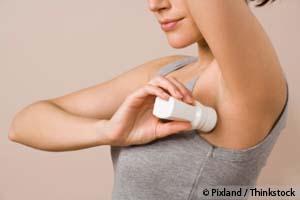- Recent research found higher concentrations of parabens in the upper quadrants of the breast and axillary area, where antiperspirants are usually applied, suggesting they may contribute to the development of breast cancer. One or more paraben esters were detected in 99 percent of the tissue samples collected from mastectomies. In 60 percent of the samples, all five paraben esters were present
- Overall, topical application of personal care products containing parabens appear to be the greatest source of exposure to these estrogen-mimicking chemicals, far surpassing the risk of the aluminum in antiperspirants
- Aluminum chloride—the active ingredient in antiperspirants—has been found to act similarly to the way oncogenes work to provide molecular transformations in cancer cells. Like parabens, aluminum salts also mimic estrogen, and bioaccumulate in breast tissue, which can raise your breast cancer risk
- Despite the fact that parabens are used in such a wide variety of products, their safety is primarily based on a rat study from 1956, as modern toxicology studies are lacking, and not a single study on the chemicals’ carcinogenity follow acceptable regulatory standard carcinogenity study protocols, according to a recent review
By Dr. Mercola
New research examining parabens found in cancerous human breast tissue points the finger at antiperspirants and other cosmetics for increasing your risk of breast canceri.
The research, which is also reviewed in an editorial published in the Journal of Applied Toxicology, looked at where breast tumors were appearing, and determined that higher concentrations of parabens were found in the upper quadrants of the breast and axillary area, where antiperspirants are usually appliedii.
Parabens are chemicals that serve as preservatives in antiperspirants and many cosmetics, as well as sun lotions. Previous studies have shown that all parabens have estrogenic activity in human breast cancer cells.
Another component of antiperspirants, aluminum chloride, has been found to act similarly to the way oncogenes work to provide molecular transformations in cancer cells. According to the authors of the editorial review, the research shows "signals of concern that such compounds are not as safe as previously generally considered, and further research is warranted." Furthermore:
"The data from this latest study, the most extensive examination of parabens in human breast so far published, confirms previous work and raises a number of questions on the entire parabens, personal care product and human health debate, particularly relating to the source and toxicological significance of the paraben esters

Replies